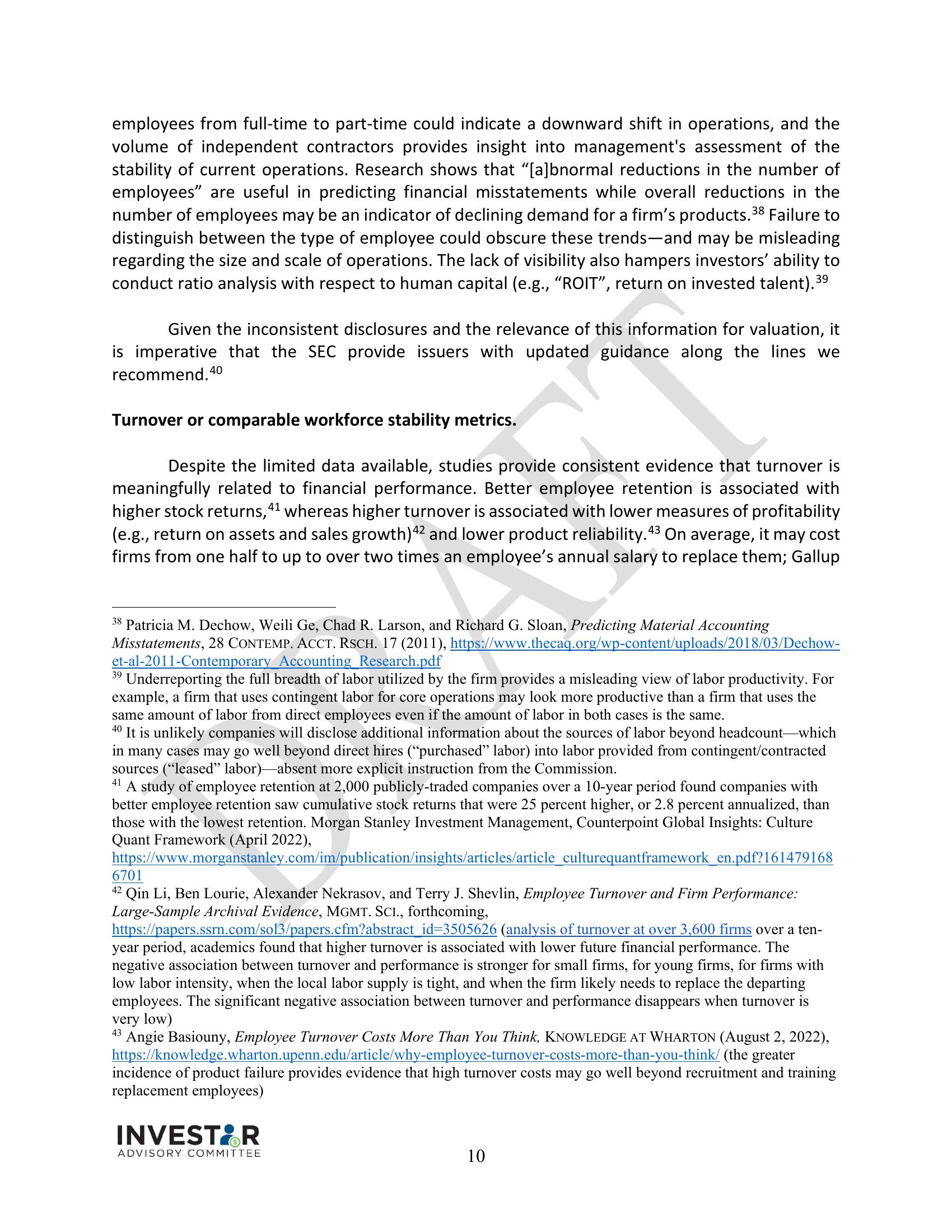Workforce Data Insight Pitch
employees from full-time to part-time could indicate a downward shift in operations, and the
volume of independent contractors provides insight into management's assessment of the
stability of current operations. Research shows that "[a]bnormal reductions in the number of
employees" are useful in predicting financial misstatements while overall reductions in the
number of employees may be an indicator of declining demand for a firm's products.38 Failure to
distinguish between the type of employee could obscure these trends-and may be misleading
regarding the size and scale of operations. The lack of visibility also hampers investors' ability to
conduct ratio analysis with respect to human capital (e.g., "ROIT", return on invested talent). 39
Given the inconsistent disclosures and the relevance of this information for valuation, it
is imperative that the SEC provide issuers with updated guidance along the lines we
recommend. 40
Turnover or comparable workforce stability metrics.
41
Despite the limited data available, studies provide consistent evidence that turnover is
meaningfully related to financial performance. Better employee retention is associated with
higher stock returns, 4¹ whereas higher turnover is associated with lower measures of profitability
(e.g., return on assets and sales growth) 42 and lower product reliability. 43 On average, it may cost
firms from one half to up to over two times an employee's annual salary to replace them; Gallup
38 Patricia M. Dechow, Weili Ge, Chad R. Larson, and Richard G. Sloan, Predicting Material Accounting
Misstatements, 28 CONTEMP. ACCT. RSCH. 17 (2011), https://www.thecaq.org/wp-content/uploads/2018/03/Dechow-
et-al-2011-Contemporary Accounting Research.pdf
39 Underreporting the full breadth of labor utilized by the firm provides a misleading view of labor productivity. For
example, a firm that uses contingent labor for core operations may look more productive than a firm that uses the
same amount of labor from direct employees even if the amount of labor in both cases is the same.
40
It is unlikely companies will disclose additional information about the sources of labor beyond headcount which
in many cases may go well beyond direct hires ("purchased" labor) into labor provided from contingent/contracted
sources ("leased" labor)—absent more explicit instruction from the Commission.
41 A study of employee retention at 2,000 publicly-traded companies over a 10-year period found companies with
better employee retention saw cumulative stock returns that were 25 percent higher, or 2.8 percent annualized, than
those with the lowest retention. Morgan Stanley Investment Management, Counterpoint Global Insights: Culture
Quant Framework (April 2022),
https://www.morganstanley.com/im/publication/insights/articles/article_culturequantframework_en.pdf?161479168
6701
42 Qin Li, Ben Lourie, Alexander Nekrasov, and Terry J. Shevlin, Employee Turnover and Firm Performance:
Large-Sample Archival Evidence, MGMT. SCI., forthcoming,
https://papers.ssrn.com/so13/papers.cfm?abstract_id=3505626 (analysis of turnover at over 3,600 firms over a ten-
year period, academics found that higher turnover is associated with lower future financial performance. The
negative association between turnover and performance is stronger for small firms, for young firms, for firms with
low labor intensity, when the local labor supply is tight, and when the firm likely needs to replace the departing
employees. The significant negative association between turnover and performance disappears when turnover is
very low)
43
Angie Basiouny, Employee Turnover Costs More Than You Think, KNOWLEDGE AT WHARTON (August 2, 2022),
https://knowledge.wharton.upenn.edu/article/why-employee-turnover-costs-more-than-you-think/ (the greater
incidence of product failure provides evidence that high turnover costs may go well beyond recruitment and training
replacement employees)
INVESTOR
ADVISORY COMMITTEE
10View entire presentation